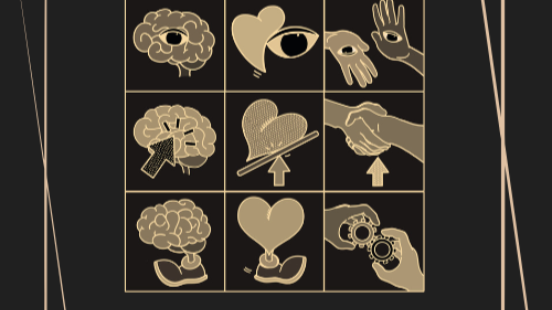Take the survey https://forms.gle/weLGNcB9vbQLKnbw5
2.5 Hypotheses (H) and research questions (RQ)
Based on the above literature, the following hypotheses and research questions were formulated:
H1. A significant proportion of HMs experience burnout with high levels of EE and DE.
H2. HMs experiencing high levels of burnout, EE and DE are expected to experience low LS
H3. Calling WO will have a positive correlation with LS and negative correlation with EE and DE.
RQ1. Is there a relationship between age, years of experience as a manager, years of experience in the current role EE and DE?
RQ2. Is there a factor among the independent variables applied in this study that can predict EE and DE?

3. Methods
The researcher integrated the limits of objectivism and the fact that theory and practice cannot always be separated. Therefore, the methodology was based on a post-positivist epistemological framework because self-reported questionnaires can be biased by many factors and narrative information from participants needs to be considered in the future for the research findings to be complete (Ryan 2006).
3.1 Participants HMs were defined as:
A) Hospitality workers working in a hotel or a corporate office who manage a team and who either report to a head of a department, general manager or a corporate director (i.e., reception manager, revenue manager, financial controller, human resources director, hotel manager).
B) Hospitality workers working in a hotel or corporate office who manage a portfolio and are accountable for a budget (i.e., purchasing manager, sales manager, revenue manager, public relations).
A total of 212 HMs participated in the study. However, 129 questionnaires were excluded because some sections of the questionnaire had not been completed. This resulted in a sample of 83 workers who held managerial positions in hospitality organisations and confirmed having more than one year’s experience in the current roles.
The sample comprised 39 men and 44 women aged from 21 to over 50 years, with the majority being 41 to 50 years old (n=31, 37.3%).
The HMs came from 16 countries and were working in 19 countries when participating in the study. More than a third (n=30, 36,14%) of respondents were not working in their native countries. France was the most represented country, with 43 respondents, followed by the UK (10) and Iceland (7).
Of these, 50% of respondents were general managers (n=42), 26.2% were head of departments or business unit managers (n=22) and 15.5% team leaders or assistant managers (n=13) while 8% of the respondents were in other types of managerial positions (n=6). The majority (n=62, 74.7%) were married or had a partner, and only 4.8% were separated (n=4).
No reward was given to participants for their contribution.
3.2 Materials.
The HMs anonymously completed three online questionnaires in English via Qualtrics. The recruitment was done mainly online via a professional social network.
Also, a link to the Qualtrics questionnaire was shared with human resources professionals within the researcher’s network.
3.2.1 Measures. The measurements of burnout, EE, DE, LS and WO were calculated using validated scales.
Burnout: The 16-item OLBI established by Demerouti and Bakker (2007), (appendix 7.4.3) was utilised because it has a more positive approach to burnout than the popular MBI. OLBI directly measures EE, engagement and DE. The participants were invited to answer 16 questions on a 4-point Likert scale, from 1= totally disagree to 4= totally agree. Of the 16 items, eight were related to EE and eight to DE. Examples of questions are: I always find new and interesting aspect of my work; There are days when I feel tired before work; and This is the only type of work I can imagine myself doing.
The OLBI questionnaire scores range from 16 to 64. A score below 30 is considered to indicate low level of burnout; between 31 and 45 indicates average level of burnout and >45 is considered to indicate a high level of burnout.
The two subscales of eight questions enabled the researcher to identify low, average or high levels of EE and DE with a range of scores from 1 to 32. The threshold for DE is below 14 for low DE, between 15 to 23 for average and >24 for a high level of DE. For EE, below 15 is considered a low level of EE, from 16 to 23 as average and >24 as a high level of EE.
The reliability test for the OLBI scale for this sample was Cronbach’s Alpha =.841.
Satisfaction with life: Satisfaction with life was measured by using Diener et al.’s Life Scale (1985) (SWLS), (appendix 7.4.2). It is a ‘5-item scale designed to measure the global cognitive judgments regarding one’s life satisfaction (not a measure of either positive or negative affect)’ (Diener et al., 1985).
The SWLS enabled the researcher to identify the participants’ LS at the level they felt it in the moment of participating (Schwarz & Strack, 1999). The participants were invited to agree or disagree with five affirmations on a 7-point Likert scale ranging from strongly disagree to strongly agree. Out of the five affirmation, four are related to the present and only the last one to the past.
Examples of affirmations are: N°1 = In most ways my life is close to my ideal; N°5 = If I could live my life over, I would change almost nothing.
The results of the scale are ranked in seven levels.
• 31-35 Extremely satisfied
• 26-30 Satisfied
• 21-25 Slightly satisfied
• 20 Neutral
• 15-19 Slightly dissatisfied
• 10-14 Dissatisfied
• 5-9 Extremely dissatisfied
The SWLS is one of the most popular scales used to evaluate satisfaction with life; several studies have contributed to confirming its reliability and validity (Diener, Inglehart & Tay, 2013; Pavot, Diener, Colvin & Sandvik, 1991). In this study, the Cronbach’s Alpha was .87.
Work orientation: WO was identified using the 3+18-item Work-Life Questionnaire (Wrzesniewski et al., 1997), (appendix 7.4.1) (upon request).
In 1997, Wrzesniewski et al. presented the work-life questionnaire built on Bellah et al.’s (1985) and Schwartz’s (1986) theory about three approaches people had towards the professional occupation, namely jobs, careers or a calling. The participants started by reading three descriptions about work and rating how closely each description matched their approach to work using a four-point scale (3=very much, 2=somewhat, 1=a little, 0=not at all like me). They then answered 18 true/false questions about their relations to work. Out of the 18 items, five concerned the individual’s behaviour and 13 concerned his or her feelings about work.
Examples of questions are: I find my work rewarding; I enjoy talking about my work to others; and my primary reason for working is financial - to support my family and lifestyle.
The true/false part had two subscales; job and calling were positioned as opposites with 15 of 18 items enabling the researcher to identify the participants’ approach to work. The remaining three items related to career orientation and were loaded consistently together as separate factors. The three items for career were: I expect to be in a higher-level job in five years; I view my job primarily as a stepping stone to other jobs; and I expect to be doing the same work in five years (reversed).
The combination of the two WO questionnaires enabled the researcher to, firstly, see how the participants position themselves based on a subjective description and, secondly, refine the results on the basis of the 18 true/false questions. A reliability test was not run as the WO questionnaire had a true/false scale. In order to compute the results, the scales were recoded (in dummy variables) and are presented in the findings as WO Descriptive scale, WO Calling, WO Careers and WO Job.
Demographics and occupation:
In order to compare groups and test RQ1, five demographic and eight occupational questions were added to the questionnaire (appendix 7.4.4), (upon request) such as questions related to age and gender. For example: What is your current role? and, for how long have you been in this role? 3.3 Procedure and data analysis The dependent variables in this research were burnout, EE and DE. The independent variables were:
• WO + subscales
• LS
• Years of experience as a manager and in the current role,
• Years of experience before this role
• Marital status
• Age
• Gender
The data was uploaded to SPSS (Statistical Package for Social Sciences), and several tests were performed to verify the reliability of the scales and normality of the data before testing the hypotheses and determining the possible correlations between the variables.
Normality tests were run to identify the appropriate tests to apply for the different hypotheses. For small samples it is recommended to consider the Shapiro-Wilk normality test. The assumption of normality for Shapiro-Wilk is significant if greater than .05. As seen in table 4 this assumption was violated for the majority of the variables (sig<=.05), meaning that most of the variables were not normally distributed.
Table 2: Normality test.

Due to the nature of the study, data was not transformed and forced to meet normality. When studying phenomena such as burnout, EE, DE and LS, it is expected to find outliers or participants presenting extreme levels of the dependent variable (figure 1 and 2).
Figure 1: Burnout normality curve.

Figure 2: EE normality curve.

For that reason, the non-parametric Spearman’s test was chosen to evaluate correlation. In addition, a stepwise multiple regression was conducted to predict the level of EE and DE based on age, gender, marital status, LS, WO, years of experience and years of experience before the current the role.
PS: This is an extraction from:
Hospitality managers’ well-being: Emotional exhaustion, disengagement and the relationship with work orientation and life satisfaction
Hrafnhildur Krumma Jonsdottir
Student n°: U1637298 School of Psychology,
University of East London, Water Lane, London
Programme: MAPPCP Term: 2-2019 Submitted on May 14th 2019
Module leader: Dr Rona Hart











